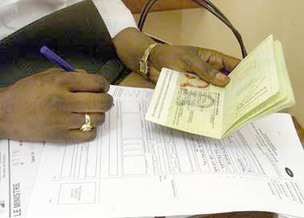
WASHINGTON, D.C. - In a move that brought cheer to Indian techies, the US Citizenship and Immigration Services (USCIS) has announced that spouses of H-1B and a handful of other visa holders will be eligible to work from May 26. “The Department of Homeland Security (DHS) is extending eligibility for employment authorization to certain H-4 dependant spouses of H-1B non-immigrants who are seeking employment-based...

lawful permanent resident (LPR) status,” the announcement said. The H-4 visa is given to spouses of those on an H-1B, as well as a handful of other, less common, visas. At present, H-4 visa holders can’t earn an income or possess a social security number.
Indians receive the majority of H-1B visas, with most working in science, tech and engineering. According to the State Department 96,753 people received an H-4 in 2013, 76 percent of whom were from South Asia. The new rule requires H-4 holders whose spouses have applied for green cards to file an application for employment authorization from May 26. The USCIS estimates as many as 179,600 people might apply this year and 55,000 annually in subsequent years.
“Allowing the spouses of these visa holders to legally work in the United States makes perfect sense,” USCIS Director LeAn Rodriguez said.
“It helps US businesses keep their highly skilled workers by increasing the chances these workers will choose to stay in this country during the transition from temporary workers to permanent residents.” “It also provides more economic stability and better quality of life for the affected families,” Rodriguez said. Permitting H-4 spouses to work was “an important element” of President Obama’s executive action announced in November, USCIS said. The action in defiance of Republican controlled Congress was aimed at fixing America’s broken immigration system and protect five million illegal immigrants, including tens of thousands from India, from deportation.
This announcement is the first reform to be implemented that’s geared towards high-skilled immigrants.
“Taking executive action to try to address some elements of our broken immigration system is consistent with the way that presidents of both parties for several decades have used their executive authority,” White House spokesman Josh Earnest told reporters.
“And there is no doubt that these kinds of changes would be good for our economy, would be good for job creation, and would be good for bringing about greater accountability to our immigration system,” he said. However, Earnest made clear that this “does not apply to people who have recently crossed the border” and on others “who may pose a threat to community safety or national security”.
South Asian Americans Leading Together (SAALT), an umbrella body of South Asian community organisations applauded the USCIS announcement as a welcome “first step that will dramatically help some families in the US”.
It called on USCIS to allow employment authorization for all H-4 visa holders, “as H-1B workers and their families are most successful when H-4 visa holders have the ability to contribute to their household income and our economy, and pursue their goals”. Telugu Association of North America (TANA) also welcomed the announcement saying “this decision is going to directly affect many of our life members as they would now be able to join the professional workforce and chase the American Dream”. (IANS)
Indians receive the majority of H-1B visas, with most working in science, tech and engineering. According to the State Department 96,753 people received an H-4 in 2013, 76 percent of whom were from South Asia. The new rule requires H-4 holders whose spouses have applied for green cards to file an application for employment authorization from May 26. The USCIS estimates as many as 179,600 people might apply this year and 55,000 annually in subsequent years.
“Allowing the spouses of these visa holders to legally work in the United States makes perfect sense,” USCIS Director LeAn Rodriguez said.
“It helps US businesses keep their highly skilled workers by increasing the chances these workers will choose to stay in this country during the transition from temporary workers to permanent residents.” “It also provides more economic stability and better quality of life for the affected families,” Rodriguez said. Permitting H-4 spouses to work was “an important element” of President Obama’s executive action announced in November, USCIS said. The action in defiance of Republican controlled Congress was aimed at fixing America’s broken immigration system and protect five million illegal immigrants, including tens of thousands from India, from deportation.
This announcement is the first reform to be implemented that’s geared towards high-skilled immigrants.
“Taking executive action to try to address some elements of our broken immigration system is consistent with the way that presidents of both parties for several decades have used their executive authority,” White House spokesman Josh Earnest told reporters.
“And there is no doubt that these kinds of changes would be good for our economy, would be good for job creation, and would be good for bringing about greater accountability to our immigration system,” he said. However, Earnest made clear that this “does not apply to people who have recently crossed the border” and on others “who may pose a threat to community safety or national security”.
South Asian Americans Leading Together (SAALT), an umbrella body of South Asian community organisations applauded the USCIS announcement as a welcome “first step that will dramatically help some families in the US”.
It called on USCIS to allow employment authorization for all H-4 visa holders, “as H-1B workers and their families are most successful when H-4 visa holders have the ability to contribute to their household income and our economy, and pursue their goals”. Telugu Association of North America (TANA) also welcomed the announcement saying “this decision is going to directly affect many of our life members as they would now be able to join the professional workforce and chase the American Dream”. (IANS)

 RSS Feed
RSS Feed
